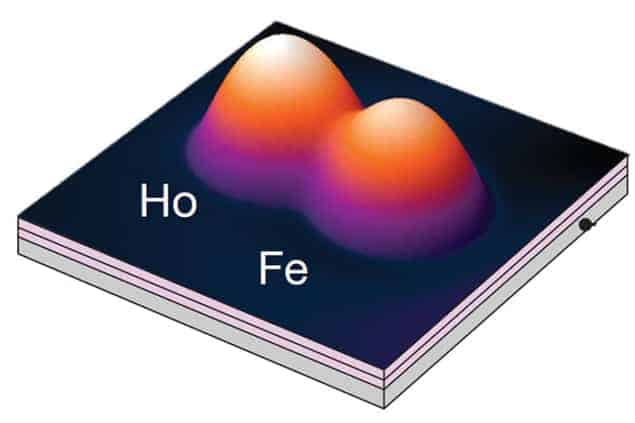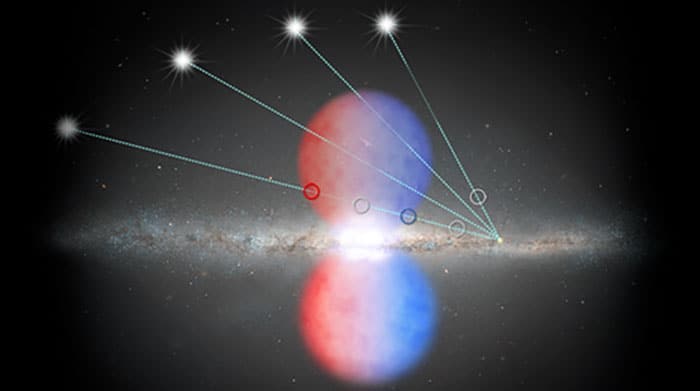Flash Physics is our daily pick of the latest need-to-know developments from the global physics community selected by Physics World‘s team of editors and reporters

Single-atom memory is world’s smallest
Information has been stored in a single atom for the first time. The nascent binary memory was created by Andreas Heinrich at the Institute of Basic Science in South Korea and an international team. It uses a high-voltage signal from the tip of a spin-polarizing scanning tunnelling microscope (STM) to set the direction of the magnetic spin of a holmium atom on a nearby surface – so that spin-up corresponds to storing a “0” and spin-down to storing a “1”. The direction of the spin is read using a single iron atom that is located adjacent to the holmium atom. This involves using the STM tip to apply a radiofrequency signal to the spin of the iron atom, causing it to oscillate. The oscillation (Larmor) frequency of the iron atom is affected by the magnetic spin state of the nearby holmium atom, allowing the stored information to be read. Using this technique, the team showed that the direction of the spin is stable for several hours. Heinrich and colleagues were surprised to discover that two holmium atoms could be placed just 1 nm apart without their magnetic fields interfering. “There are no quantum mechanical effects between atoms of holmium,” says Henirich. “Now we want to know why.” This ability to pack the atoms close together could mean that the storage technique could be used to create high-density memories. The work is described in Nature.
Black hole blew Fermi bubbles six million years ago

The supermassive black hole at the centre of the Milky Way had its last big meal roughly six million years ago. That’s the conclusion of a team of astronomers who used data from NASA’s Hubble Space Telescope to show that the last big object to be consumed by the black hole was a large clump of gas. The Milky Way’s supermassive black hole has the mass of 4.5 million suns and therefore any material that gets too close is drawn in by its powerful gravitational force. The material then swirls around the black hole until it is eventually consumed. However, the material can get so hot that some of the matter escapes along the black hole’s spin axis. Rongmon Bordoloi from the Massachusetts Institute of Technology in the US and colleagues believe that this happened to a large clump of gas six to nine million years ago, and the ejected matter created the huge lobes of material – called Fermi Bubbles – above and below the Milky Way. The team used observations from Hubble’s Cosmic Origins Spectrograph (COS) to analyse the ultraviolet light from 47 galaxy cores – called quasars – including the Milky Way. As the light travels through the bubbles it carries information about the gas speed, temperature and composition. The results provide a new insight into Fermi Bubbles, including how old they are. “We have traced the outflows of other galaxies, but we have never been able to actually map the motion of the gas,” says Bordoloi. The group also saw the presence of silicon and carbon – the fossil remnants of the stellar evolution. The research is described in The Astrophysical Journal.
Polymer coating stabilizes ultrathin silicon

A new way of stabilizing sheets of silicon just one atom thick has been developed by researchers at the Technical University of Munich. Since it was first isolated in 2004, graphene has been shown to have a number of unique and potentially useful electronic properties. Many of these arise from the fact that the material is also just one atom thick, and as a result, physicists are keen to create other ultrathin materials with potentially useful properties. Silicon is an intriguing candidate because it is already widely used in electronic devices, and ultrathin sheets of the material have promising optoelectronic properties. Unfortunately, ultrathin sheets of silicon are extremely delicate and disintegrate when exposed to ultraviolet (UV) light. Now, Tobias Helbich, Bernhard Rieger and colleagues have embedded silicon nanosheets in a polymer to protect them from decay. “What makes our nanocomposite special is that it combines the positive properties of both of its components,” says Helbich. “The polymer matrix absorbs light in the UV domain, stabilizes the nanosheets and gives the material the properties of the polymer, while at the same time maintaining the remarkable optoelectronic properties of the nanosheets.” The team also created a photodetector by mounting several of the coated silicon sheets on a silicon-dioxide surface that is coated with gold contacts. The research is described in Journal of Physics D: Applied Physics.
- You can find all our daily Flash Physics posts in the website’s news section, as well as on Twitter and Facebook using #FlashPhysics. Tune in to physicsworld.com later today to read today’s extensive news story on a new low-cost source of ultraviolet light.



